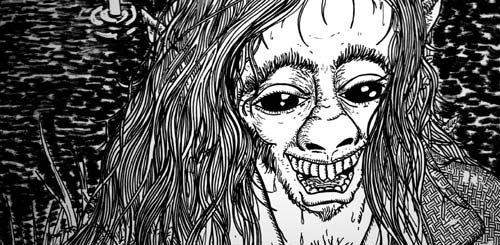Black Dogs and Phantom Hounds, Part One: Maryland and Delaware
Legends of black dogs and phantom hounds are widespread throughout the Chesapeake Bay region, which was one of the earliest areas settled by the English. The tales of British black dogs were combined with werewolf traditions and typical ghost stories, as well as possibly with cryptozoological sightings of weird creatures, to create a tradition that is like the Britsh ones, and yet unlike them at the same time.
Black Dogs of Warfieldsburg
The tiny village of Warfieldsburg in Carroll County is haunted by a black dog. Recounted by Maryland folklorists Annie W. Whitney and Caroline C. Bullock is the story of two men who were riding along near the Ore Mine Bridge at dusk around 1887. They saw a large black dog which passed through a fence, crossed the road, and passed through another fence. Whitney and Bullock also recount the tale of a man who stood under a tree near a bridge, possibly the Ore Mine Bridge, because he was told a phantom black dog would come by. The dog appeared, and according to him the dog followed him for a brief time before vanishing. Yet another instance was of a man who saw a black dog dragging a length of chain. This black dog can apparently never appear more than once to the same person, and it is said that the crack of a whip near it will cause it to vanish. In some variants of the story, the dog is the phantom of Leigh Masters, a notorious Carroll County landowner who was supposedly quite cruel. Masters is also associated with the haunting of Avondale, his manor house.
There was a case in 1975 in which a group of motorists supposedly struck a large black dog standing on a road near Warfieldsburg. They felt the impact of the strike and felt the animal under the wheels, but when the car passed by the black dog was standing in thre road, baring its teeth at them before vanishing.
Blue Dog of Rose Hill (1)
Perhaps the oldest ghost story of Maryland is that of the Blue Dog of Rose Hill. Near the town of Port Tobacco (Charles County) is a rock covered in reddish discolorations. Called the “Peddler’s Rock”, it supposedly marks the spot where a trader was killed at some point in the latter part of the 1700s. In true ghost story fashion, there are many variants of the tale. Some have it that the body was found lying on the rock, some that the body was buried. Some have it that the victim was not a trader, but a returning Civil War soldier. In any case, the man’s money was left behind, and his dog – a great blue-tinged mastiff almost black – was killed during the murder. After the crime, the men returned to seize the treasure and warded off by howling and were charged by a large, luminous dog.
During the Civil War, men under the command of General Joseph Hooker supposedly tried to retrieve the peddler’s treasure but were, like the murderers, frightened away by howling and the approach of a large hound. I don’t know of any confirmation of this story, but in the early 1860s General Hooker was, indeed, engaged in maneuvers around Washington, D.C. (the number of camp followers attached to Hooker’s army, by the way, were the source of hooker, a common slang term for prostitute). As recently as February of 1971, locals claimed to hear the howling of the dog coming from the vicinity of the Rock.
Blue Dog of Rose Hill (2)
It could be just another variant of an urban legend or a wholly separate story, but the city Frederick (Frederick County) has its own Blue Dog of Rose Hill. The grounds of Rose Hill Manor off Route 355 in the northern part of the city are also haunted by a phantom blue dog. This blue dog was the pet of a previous owner of the manor. The owner had buried treasure “six feet from the old oak tree” on the property. The ghostly dog appears at midnight, wanders the grounds, and vanishes as mysteriously as it appeared. Now-deceased Maryland researcher Mark Chorvinsky of Strange Magazine investigated the tales of the Frederick Blue Dog.
Snarly Yow
“Snarly Yow” is the name given to a phantom hound which haunted a section of the National Pike near Turner’s Gap (Frederick County). The hound was first mentioned by Madeleine V. Dahlgren in 1882. Her book South Mountain Magic details no less than a dozen sightings of the beast. One account is from a Daniel Mesick, whose father kicked at a huge dog near Dame’s Quarter. His foot passed directly through it. Sticks, rocks and even bullets were recorded as having passed through the beast in Dahlgren’s accounts. Other accounts have stated that the dog left physical traces and frightened horses to the extent that they threw their riders. The dog was seen numerous times by a minister at a small church in Glendale. A staple of Frederick County legendry for years, the Yow was seen in 1962 near Zittlestown. In this instance, it was headless, white, and drug a chain along behind it.
The South Mountain area is also the traditional home of a number of werewolves.
Fence Rail Dog
The Fence Rail Dog is an enormous hound, nearly ten feet in length, which haunts a stretch of Route 12 near Frederica in Delaware. Mentioned by Charles J. Adams III, a Pennsylvania-based author on paranormal topics, the dog appears in the wake of automobile accidents on the road. Not much information is at hand, but as folklore from around the globe speaks of dogs as a sort of psychopomp, or spirits which guides the dead to the afterlife, its appearance in the wake of death may be an interpretation of this.
Red Dog Fox
The Brandywine Creek State Park in northern Delaware near Wilmington is home to appearances of a large dog or fox which is often seen to rise up into the apparition of Gil Thoreau, an outdoorsman. Once again, not much information is known on this creature.
Bullbegger Creek
It isn’t technically in Maryland or Delaware, but in the northern portion of the small finger of Virginia on the Delmarva Peninsula is a feature called Bullbegger Creek. There is also a nearby village called Bullbegger. British readers will be familiar with the term, which referred to a phantom or goblin that haunted several regions across the isle. Traditions do exist in Virginia of free-roaming humanoid phantoms which change into black dogs, but I can’t place those traditions geographically and can’t say definitively whether this accounts for Bullbegger Creek’s name. It is certainly an odd name, however! I wouldn’t doubt there are some sort of traditions are around there.
As can be seen from the above cases, the phantom hounds found in this region of the eastern United States are both similar to, and different from, the British cases. Chain-dragging seems to be a fairly common feature of the accounts, as it is in the cases of the Gytrash and other English hounds. Only the dog haunting Warfieldsburg is reputed to follow individuals as is common in the British lore. Another common feature of the stories (also common to Pennsylvania lore, as will be discussed later) is a clearly phantasmal nature, and in several of the instances the dog is clearly defined as the phantom of a specific individual.
An interesting facet of the case is that the dog traditions seemed to for the most part die off in the 1970s, the late 1960s and 1970s being the timeframe that Bigfoot sightings began in earnest in Maryland. Also interesting is that some sightings, particularly of Frederick County’s “Dwayyo” in 1973, do have a rather canine cast to their features. One wonders whether some of what are reported as Bigfoot sightings are actually sightings of black dogs.
By Andrew Gable




Recent Comments